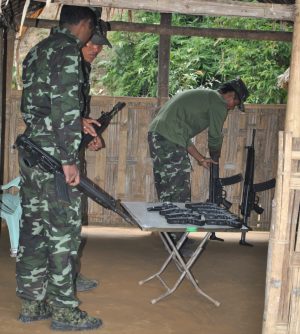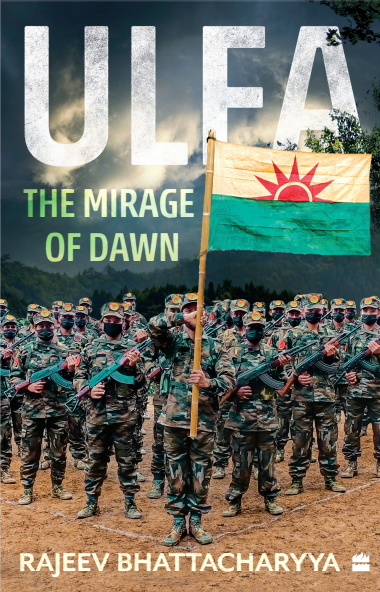The Chittagong Arms Haul of 2004 in Bangladesh is considered the biggest confiscation of illegal weapons in South Asia to date. According to media reports, arms, which were sourced mainly from China and Singapore, were purchased by a banned Indian militant outfit, the United Liberation Front of Asom (ULFA). An investigation by the author revealed that it was an operation by Pakistan’s spy agency, the Inter-Services Intelligence (ISI), under ULFA’s banner. The plan was to store the weapons in underground chambers at ULFA camps in Bangladesh and eventually distribute them to different rebel groups in India.
What triggered the confiscation of the consignment by the Bangladesh authorities remains unclear to date.
The weapons that arrived at Chittagong were among several consignments that ULFA had firmed up from overseas destinations. Most of these consignments were received in trawlers from the sea abutting the coastal Bangladeshi city of Cox’s Bazar. Some of the shipments were sourced from places as far away as Romania, and several from China and Pakistan. While a large chunk was confiscated on different occasions, a sizable quantity was ferried to the outfit’s camps in Satcherri and Sherpur, from where they were also given to other rebel groups.
The following overview of the Chittagong Arms Haul is an excerpt from the recently released book “ULFA: The Mirage of Dawn” by Rajeev Bhattacharyya, published by HarperCollins..
The 1,500 boxes the police seized were new Chinese munitions worth an estimated $4.5–7 million. They consisted of a wide array of weapons, including T-56-1 7.62 mm assault rifles, Uzi and T-85 submachine guns with integral silencers, T-69 40 mm rocket-propelled grenade launchers, optical sights T-69 RPG launchers, T-82-2 hand grenades, RPG warheads, ammunition, and walkie-talkie communication sets. That a small quantity of non-Chinese weapons was also included was evident from the presence of the Uzi submachine guns, which had originated in Israel years ago. Although their place of manufacture is unclear, it is highly probable that the ship received the submachine guns and other non-Chinese items in Singapore after sailing from Hong Kong.
The government was in a fix as the episode snowballed into a major controversy, grabbing media attention across several countries. There was an uproar in India when it became known that the weapons were meant for ULFA and other rebel groups in the country. The issue gained added significance when Chittagong City Mayor and Awami League leader A.B.M. Mohiuddin Chowdhury claimed that the weapons were sent by the U.S. and Pakistan to arm Indian rebels stationed in the Chittagong Hill Tracts. Then-opposition leader Sheikh Hasina demanded an international probe while pointing fingers at a section of Bangladesh Nationalist Party (BNP) leaders for their involvement in the incident.
Deeply embarrassed by the episode, the Bangladesh government appointed a five-member high-powered inquiry committee headed by Home Secretary Omar Faruk. However, no deadline had been fixed for the committee to file its report. The home secretary confirmed the involvement of three persons in the smuggling, pinned the blame on the police for failing to arrest them, but found “no political links” to the incident.
Within a month, the CID was also allowed to probe the incident after investigating officer Ahadur Rahman was relieved of the task for his controversial role in the episode. A report on June 11, 2004 named 43 people in the case filed under the Arms Act. Around three months later, a supplementary charge sheet was submitted by another investigating officer, where one more name was added to the existing list. He also probed the arms smuggling case and submitted the charge sheet in November, accusing 45 people.
So, what went wrong with the operation?
Certainly, the police would not have dared to seize the consignment if there was no instruction from the Home Ministry. And yet, several bigwigs were involved in the operation from the outset, including at least two ministers from the government and highly placed officers from the intelligence agencies.
Several theories were doing the rounds among the ULFA functionaries in Dhaka after the confiscation and constitution of the probe. According to the first, the Central Intelligence Agency (CIA) of the United States was tipped off about the arrival of the consignment by its loyalists in the DGFI who were not part of the operation. The CIA grew apprehensive that a major portion of the weapons would be grabbed by the burgeoning fundamentalist outfits in Bangladesh, which would only make the situation in the country similar to that of Afghanistan. Subsequently, the American government pulled strings in the BNP-led government to foil the operation.
The second theory suggests that an Indian intelligence agency had received information about the weapons deal, probably from its sources among the rebel groups in the Northeast. The agency began to make efforts at a higher level to prevent the weapons from falling into the hands of ULFA. Two key functionaries of the BNP — State Minister of Home Affairs Lutfozzaman Babar and then-Prime Minister Khaleda Zia’s son, Tarique Rahman — were persuaded to get the weapons seized after they arrived at a consensus following promises of business deals. They swung into action by issuing instructions to the police in Chittagong a couple of days before the trawlers arrived at the jetty.
Anup Chetia, ULFA’s general secretary, did not believe it was a case of “back-stabbing,” given his interaction with two police personnel in a Dhaka jail, where he was incarcerated when the seizure was made. (Chetia was jailed in Bangladesh in 1997 and released and extradited to India in 2015.) The two police personnel he met in jail had been convicted after being caught stealing a few weapons from the seized consignment. They arrived at the jetty in Chittagong when the weapons were being transferred from the trawlers, but they did not know that the shipment belonged to ULFA. They assumed it was a case of smuggling, which could offer them scope to earn a quick buck. They only realized their plan was not feasible when Hafizur Rahman told them sternly that the consignment had the approval of the government. Subsequently, they informed their seniors, who reached the spot within a few minutes.
These theories notwithstanding, it is difficult to ignore the fact that it was an extremely ham-fisted operation at Chittagong. If the weapons had not been confiscated, at least three more trucks would have been necessary for transporting the consignment from the two trawlers. Arranging for more vehicles would have certainly caused more delay in completion of the operation. And if the crane had not broken, all the four trawlers would have been packed with weapons. This would have necessitated at least 26 trucks at the jetty, which was not anticipated by ULFA. In all probability, the operation would not have remained shielded from the media.
For ULFA, though, there was no immediate impact from the calamity, as its arsenal was still big enough to sustain its campaign in Assam. It had shelled out around 10 million rupees as payment for the two trawlers that had fetched the weapons from the sea. Paresh Baruah, then the chief of ULFA’s military wing, was left embarrassed before the rebel outfits from whom he had taken advance payment for the weapons. His reputation as the reliable gun merchant took a serious hit.
It was a quirk of fate for ULFA that two of the biggest seizures of weapons were made not during the regime of the Awami League but that of the BNP, which distinctly favored the rebel groups from the Northeast. It was not until 2014, after the Awami League-led coalition returned to power, that the probe reached its logical conclusion. Charge sheets were compiled and the court awarded the death sentence to 14 persons. The long list included Paresh Baruah, former industries minister and Jamaat-e-Islami chief Motiur Rahman Nizami, former minister of state for home affairs and senior functionary of BNP Luftozzaman Babar, and two former chiefs of Bangladesh’s intelligence agencies.
Baruah was at a safe destination, away from the country, when the verdict was delivered; today, he heads the anti-talks faction of the militant group, called ULFA-Independent.
(Excerpted with permission from HarperCollins Publishers India.)


































